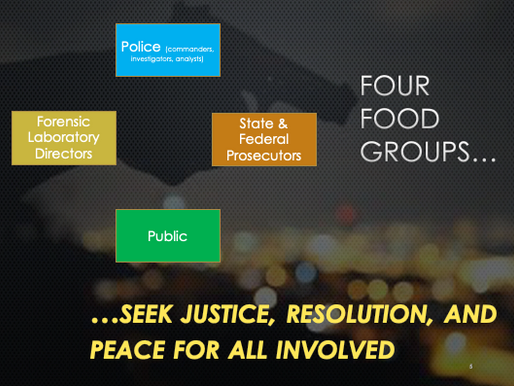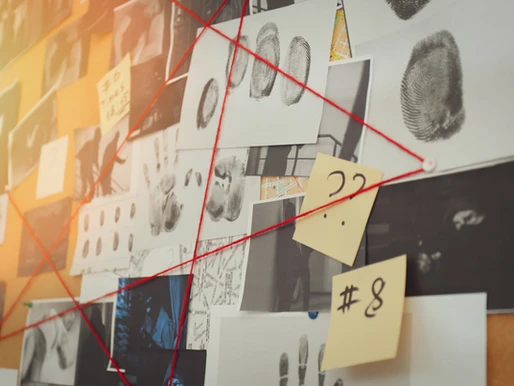“If you want to build a ship, don’t drum up people to collect wood and don’t assign them tasks and work but rather, teach them to long for the endless immensity of the sea” – Antoine de Saint-Exupéry
When he approached the lectern, my eyes were squarely focused on those detectives long in the tooth. What was this former United States Attorney going to tell these grizzled gumshoes about investigating gun violence? They have seen it all, right! They experience the daily impact of “ping-pong” murders where today’s victims become tomorrow’s shooters thanks to the advances in trauma technology. The names of the serial shooters and their victims in their jurisdictions are as familiar as street signs to them. I steadied myself and focused on a mental reminder: this guy is good! But then he advanced his first slide. It depicted an autocrat lecturing his audience with the message, “We’re not doing anything because we don’t want to, and you can’t make us.” Oh, no, I thought to myself what have we done?!”
Rewind to a few weeks earlier, when the FBI released statistics concerning violent crime. They reported a 30% increase in murders for 2020, and how it was the deadliest gun violence year in decades. To make matters worse, those same patterns of violence have continued throughout this year in 2021, surely shaping it up to be a far worse year than the last. Bob Troyer, the former United States Attorney of the District of Colorado, and I were amid planning discussions aimed at presenting a New Jersey workshop for prosecutors, detectives, and commanders. Bob had recently developed the NIBIN Toolkit for Prosecutors[1], and I had been back in the saddle speaking about building crime gun intelligence capacities. With New Jersey telegraphing a history making effort that would harness the power of prosecutors in defeating gun crime, it only seemed right that the two of us should team up and present shoulder-to-shoulder of what we knew about precision awareness and precision prosecution concerning gun crime.
Despite what it appeared, like others in the audience, I had walked myself into this adroit Prosecutor’s trap. His self-deprecating humor was his tactful reminder that the challenging of the status quo for the sake of continuous improvement requires that our egos be left out in the parking lot. But most importantly, it cast a spotlight on the importance of building and leveraging relationships among the disparate communities of interest needed to advance successful gun violence prevention and suppression programs. Troyer worked us like he would work a jury by boiling issues down to the most basic concepts, so we could better understand, and later apply them.
His ruse helped tease out that having a robust capability to identify and prosecute gun violence requires the informal and formal partnerships among diverse entities within the law enforcement community. In other words, patrol officers, detectives, analysts, ballistic and forensic technicians, commanders, and prosecutors must all partner. They must think and act together to share information and insight. More specifically, these stakeholder entities must coalesce around a shared purpose, shape that shared purpose via policy, and then develop protocols to implement and adhere to those policies to realize the overall shared vision.
We cheerfully label these disparate entities as basic “food groups” because like understanding the relationship of good nutrition to our overall health, we need a reference point to better understand what contributes to a precision awareness and prosecution capability in the pursuit of justice for all. It is the diversity of the stakeholders that contributes to the overall strength of this capability, yet that same diversity of mission sets can also represent a hurdle to most.
The reason these independent “food groups” need to communicate, coordinate, and collaborate becomes even more apparent when one is asked to think of the amount of time a detective or forensic examiner gets to speak with prosecutor. The answer is hardly ever. While it is critically important that each of these entities performs a specialized function, the nature of law enforcement does not often allow these individual disciplines to communicate day-to-day and develop critical information sharing relationships.
Building a robust crime gun intelligence capability requires an “all in” participation from police commanders and investigators, while also requiring the technical skills and equipment of forensic laboratory personnel, and the legal acumen of state and Federal prosecutors. These stakeholder groups must work together to achieve success.
When the French Aviator and writer Antoine de Saint-Exupéry wrote the quote that opened this post in his book “The Little Prince” it inspired many to take up their vocations. Moreover, the quote has been used for years to inspire teamwork among diverse entities by focusing them on a shared vision. Having a shared purpose can also serve as the end state for stakeholders charged with reducing gun violence regardless of their disciplines.
Notwithstanding, we must also add the public we serve to the list of basic “food groups”. Their interest in gun violence may be the most intimate because of the impact it has on victims, families and communities. Therefore, a shared purpose allows – no requires – the public to be an active contributor to the diverse capabilities needed to combat gun crime.
Seeking justice for victims, resolution for their families, and peace for the communities impacted by gun violence can align and harness the energies and capabilities of the investigators in the street, the technicians in the lab, and the prosecutors in the courtroom, all while carrying out what the public expects from law enforcement when addressing gun violence. When Bob Troyer presents on strategies needed to combat the blight of gun violence, he does so by recognizing that there is an unintended consequence of the specialization that underpins law enforcement community capabilities aimed at gun violence. He understands that specialization can often result in silos that prevent communication, coordination, and collaboration. He accepts that advancing robust crime gun intelligence strategies requires many “handoffs and handshakes” among partners and the public who must have trust in one another to leverage each other’s capabilities.
Success will require that we all think and act together so that armed and violent criminals cannot operate with impunity – and as we do – leave our egos and preconceptions parked outside.
[1] The First Edition of the NIBIN Toolkit for Prosecutors, authored by Bob Troyer, Esquire, was published in June 2021 by Ultra Electronic Forensic Technology Inc.



